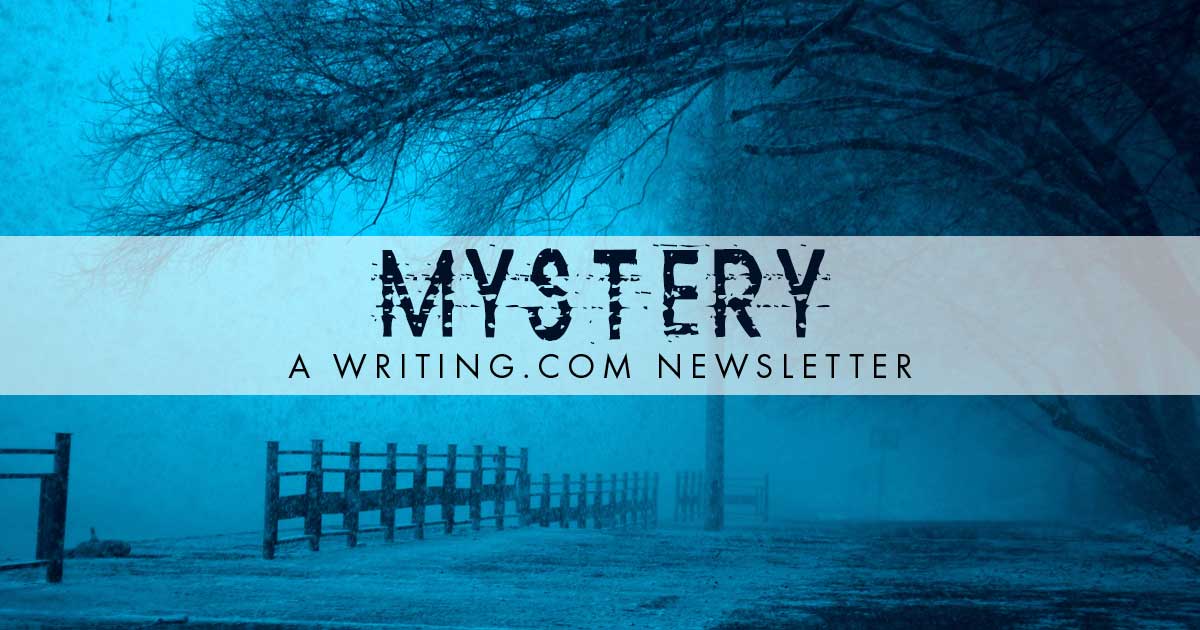This week: Steps. Why’d it have to be Steps? Edited by: Carol St.Ann 👓  
More Newsletters By This Editor 
![Table of Contents [#401437]
Table of Contents](https://www.Writing.Com/main/trans.gif) ![Table of Contents [#401437]
Table of Contents Table of Contents](/main/images/action/display/ver/1709303267/item_id/401437.png)
1. About this Newsletter
2. A Word from our Sponsor
3. Letter from the Editor
4. Editor's Picks
5. A Word from Writing.Com
6. Ask & Answer
7. Removal instructions
![About This Newsletter [#401439]
About This Newsletter](https://www.Writing.Com/main/trans.gif) ![About This Newsletter [#401439]
About This Newsletter About This Newsletter](https://www.writing.com/main/images/action/display/ver/1709303676/item_id/401439.png)
| ”Suspense keeps you on the edge of your seat, while a Thriller makes you ‘jump off’ your seat." — Eugenio Gattinara |
![Letter from the editor [#401442]
Letter from the editor](https://www.Writing.Com/main/trans.gif) ![Letter from the editor [#401442]
Letter from the editor Letter from the editor](https://www.writing.com/main/images/action/display/ver/1709303784/item_id/401442.png)
Greetings, Mystery Writers!
As promised, this month I’ll be diving into the deep mechanics of the thickened plot and the payoff of writing a riveting Suspense.
Introduce your protagonist, who should of course be likable and have traits and an issue that will endear him or her to the reader.
Similarly, your supporting characters should be familiar types. A little guessing, over whether or not they are friend or foe never hurts, but keep it trite and reasonable. Overall, their trustworthiness is valuable to the story.
The villain is the character who will need the most attentive engineering. Proceed with caution. Keep top of mind: The smarter and more powerful this character (or entity) is, the smarter and more powerful your protagonist will ultimately be in order to have defeated them.
Intellectually pose (aka:SHOW) the dramatic question to give the reader a reason to return to the story until it is answered.
We’ve established that the main elements of Suspense are empathy, concern, impending danger and escalating tension.
To encourage empathy, give the character(s) a desire, a physical or emotional wound or scar, or an internal struggle common enough for readers to identify with. Love, revenge, fear, injustice. You get the picture.
To encourage concern, give the character losses & wins. Another way to look at this is the one step forward; two steps back syndrome. Protagonist discovers a clue that opens a Pandora’s box of confusion, or brings more strife, trouble, danger, or heartache than if it had been ignored or left alone.
To encourage impending danger and escalating tension, pepper in some classic foreshadowing. Give the reader a bit of information the characters don’t notice. ** Be wary of the omniscient narrator’s voice here. Use peripheral vision instead of a narrator.
Remember to occasionally hint at the answer to the dramatic question. This rejuvenates the reader’s push toward the end goal.
And last, but of the utmost importance: Hold that reveal!
Don’t give away the conclusion too soon.
Thank you for reading.
See you next month!
=====•=======•
One Last Thing!
Remember to nominate great mysteries!
|
![Editor's Picks [#401445]
Editor's Picks](https://www.Writing.Com/main/trans.gif) ![Editor's Picks [#401445]
Editor's Picks Editor's Picks](https://www.writing.com/main/images/action/display/ver/1709303830/item_id/401445.png)
If you’ve got a mystery in your head:
Try out your mystery chops here:
| |  | Invalid Item 
This item number is not valid.
#2281662 by Not Available. |
Flesh out your mystery story here:
or here (coming soon): | |  | Invalid Item 
This item number is not valid.
#2225991 by Not Available. |
Workshop it here with dedicated, in-depth reviews:
Enjoy these great reads and consider sharing your suspense story with this newsletter!
| |  | Invalid Item 
This item number is not valid.
#2294118 by Not Available. |
| |  | Invalid Item 
This item number is not valid.
#2293992 by Not Available. |
|
![Word From Writing.Com [#401447]
Word from Writing.Com](https://www.Writing.Com/main/trans.gif) ![Word From Writing.Com [#401447]
Word from Writing.Com Word from Writing.Com](https://www.writing.com/main/images/action/display/ver/1709303874/item_id/401447.png)
Have an opinion on what you've read here today? Then send the Editor feedback! Find an item that you think would be perfect for showcasing here? Submit it for consideration in the newsletter!
https://www.Writing.Com/go/nl_form
![Ask & Answer [#401448]
Ask & Answer](https://www.Writing.Com/main/trans.gif) ![Ask & Answer [#401448]
Ask & Answer Ask & Answer](https://www.writing.com/main/images/action/display/ver/1709303902/item_id/401448.png)
Who’s your favorite writer of suspense.
What’s your favorite Dramatic Question to read or write? |
![Unsubscribe [#401452]
Removal Instructions](https://www.Writing.Com/main/trans.gif) ![Unsubscribe [#401452]
Removal Instructions Removal Instructions](https://www.writing.com/main/images/action/display/ver/1709303960/item_id/401452.png)
To stop receiving this newsletter, click here for your newsletter subscription list. Simply uncheck the box next to any newsletter(s) you wish to cancel and then click to "Submit Changes". You can edit your subscriptions at any time.
|
